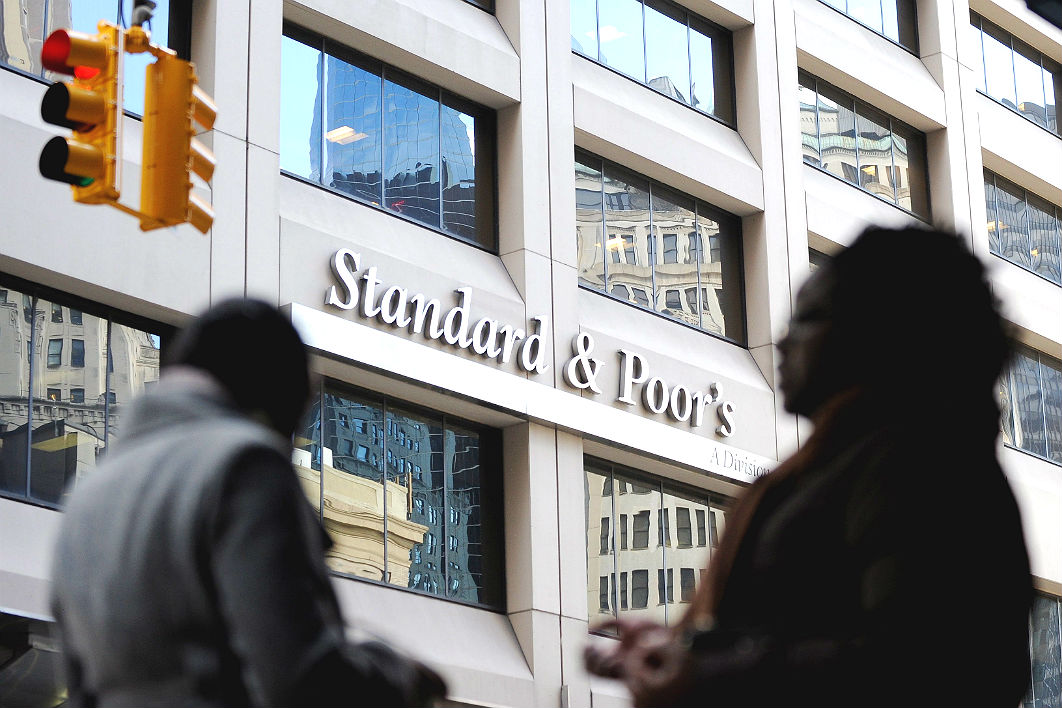Ten years after the global financial crisis began destroying businesses and livelihoods, the major credit rating agencies — Moody’s Investors Service, Standard & Poor’s and Fitch Ratings — are still standing. Despite the vehement criticism of their awarding of favourable ratings to exotic financial products that suddenly turned toxic, and despite congressional committees and commentators all over the world calling for new regulations to curb their behaviour, the Big Three seem as influential as ever.
As the European sovereign debt crisis showed, their return to influence was swift. Banks in five Europeans countries in particular — Portugal, Italy, Ireland, Greece and Spain — had lent far too generously to real estate speculators; in the panic following Lehman Brothers’ bankruptcy in September 2008, real estate values plummeted and banks’ balance sheets were devastated. In each of those countries, governments bailed out the banks, imperilling their own finances.
Where did the agencies come in? Before the crisis, the Big Three had given those governments generous ratings, apparently on the assumption that Germany and other richer eurozone members would bail them out if they got into difficulty. When that assumption was proved wrong, the agencies aggressively downgraded the five countries’ debt issues, making the European crisis worse than it might otherwise have been. Their decades-old position at the centre of the financial world had been reasserted.
Rating agencies emerged in the United States after the civil war. Between 1865 and 1914, in the absence of reliable, publicly gathered statistics, private operators produced an explosion of information targeted at participants in American financial markets. But it wasn’t until the 1907 financial crisis that companies turned from issuing aggregated information to making judgements about the creditworthiness of borrowers. The 1907 crisis demonstrated the heightened volatility of finance, and ratings looked like a useful tool.
By the mid 1920s, the agencies had taken on a de facto role in regulating public finance in the United States. By law, municipal bonds could only be issued if they were rated by Moody’s. But bond rating was a fledgling activity up to the 1930s, when banking and securities businesses were separated by the Glass–Steagall Act. Rating agencies entered a period of rapid growth and consolidation, further fuelled by the institutionalisation of the securities business after 1929. When many state governments incorporated rating standards into their prudential rules for pension-fund investments, rating became a standard requirement for any debt issue in the United States.
Later, in the mid 1970s, the US Securities and Exchange Commission anointed Moody’s, Standard and Poor’s and Fitch as “nationally recognised statistical rating agencies,” whose seal of approval ensured preferential treatment for a borrower’s bonds. The agencies grew in size and power, not only in the United States but also across the Western world.
The power they had accumulated helps explain the sharpness of the criticism at the height of the global financial crisis. The result was a swathe of new regulations governing their activities in the United States and Europe. Not surprisingly, the rules were designed to be “heavier” or “harder” or somehow more “serious.” Yet they left the business model and analytical processes of the agencies unaffected. Why? Because governments and other regulators didn’t understand exactly what the rating agencies had done wrong, just as they failed to recognise the nature of finance and the circumstances that had created the global financial crisis.
Behind the impulse to punish and regulate is the idea that the people at the agencies were doing things that were wrong in the sense that a mechanic who downloads the incorrect updates to your car’s computer is doing something wrong. But that analogy won’t do for global finance. Finance markets are not a natural or physical phenomenon: they may display regularities in normal times, but these regularities are not law-like. Change is an ever-present feature of all social mechanisms.
The American philosopher John Searle makes a useful distinction between two types of rules — regulative rules and constitutive rules. Regulative rules are simply directions — drive on the left side of the road, for instance. Constitutive rules “do not merely regulate, they create or define new forms of behaviour.” The inventors of chess and football created a set of constitutive rules — and those rules made the game.
The panicky response to the global financial crisis focused on regulative rules (or the lack of them) and on those people and organisations that allegedly broke those rules. But the crisis, and the behaviour of the rating agencies, reflected changes in the constitutive rules of finance.
For the rating agencies, the constitutive change came with the rise of “structured finance” in the early 1980s. Structured finance is the main financial innovation that allowed the financial sector to convert “illiquid” credit card debts, car loans and mortgages into tradeable, “liquid” securities. With interest rates low and higher returns much sought after, structured finance grew to around US$10.7 trillion in 2007.
When people think of financial innovation, they inevitably think of computers and highly educated “rocket scientists” developing new techniques for managing risk. But that is not at the heart of the problem. Lawyers are the key, for the essence of structured finance is to be found in the legal rights allocated to different classes of bondholder in the contracts and trusts that underpin securities. These legal underpinnings, which can run to thousands of pages, give different rights to different tranches of a security.
This is how a mass of not very creditworthy subprime mortgages could produce a AAA-rated return for some investors, while other investors in the mortgages ended up well down the queue. The AAA investors had first right to revenue, and the expectation was that even if some subprime mortgage–holders defaulted as expected, enough would pay that those with highly rated securities would be paid in full. Unfortunately, when expectations are upset and people are full of uncertainty, as in 2007–09, the model doesn’t work. When recession is added to the mix, the result is a wholesale write-down of the global market in securities.
As disastrous as this situation was, the rating agencies’ real failure lay elsewhere, namely in their own move into the markets. For decades, Moody’s and Standard & Poor’s had played the role of judge or referee, standing back from the action and making calls as necessary. They were valued for this role, and it allowed them to build up substantial reputations. But structured finance was only possible if the rating agencies were involved in designing the financial instruments.
It was the agencies and their ratings that created the distinct tranches. Because of the complexity of the legal documentation and protection necessary for these tranches, the raters acted more like consultants, helping to construct the securities and indicating how they would rate them if they were organised in ways that offered specific legal protection to investors.
When regulators did attempt to tackle the constitutive rules at the heart of rating, following the global financial crisis, the agencies didn’t take it lying down. In 2010, Barack Obama signed into law the Dodd–Frank Act, which focused on public oversight and accountability, standards of liability and concerns about conflicts of interest. Dodd–Frank repealed the Securities and Exchange Commission’s Rule 436(g), which had protected the agencies as opinion-givers under the First Amendment to the US Constitution. The repeal exposed the agencies to potential “expert” liability when ratings were included in asset-backed security registration statements.
Unimpressed, the agencies immediately prohibited debt issuers from including their ratings in prospectuses or debt registration statements. Congress hadn’t anticipated this reaction. With the trillion-dollars asset-backed securities market severely disrupted, Rule 436(g) was reinstated by the Asset-Backed Market Stabilization Act of 2011. The power of the credit rating agencies was reasserted and the limited capacity of regulators to reform the constitutive rules was demonstrated.
Rating agencies are not like financial institutions. They don’t trade or sell securities. They create knowledge. This feature of the agencies has been troublesome for US and European regulators, who have created many new rules that are costly for the agencies but ultimately trivial in their effects. But they have not tackled the business model and analytical process. And where they have pursued the core foundations of rating, they have been stopped by the superior resources of the agencies. ⦁




